Birmingham 2022: BBC R&D achieves two firsts during 5G trial
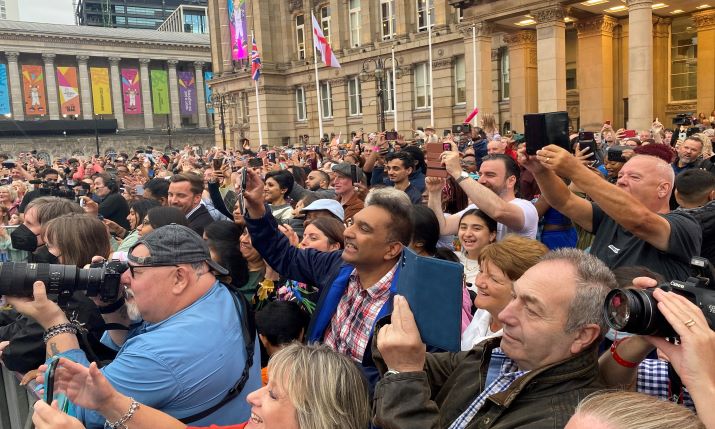
“Crowds usually present a challenge for cellular contribution as we fight for capacity with all users. The private 5G network means we are isolated from this,” says BBC R&D’s Ian Wagdin
Last week saw the opening of the Commonwealth Games in Birmingham and, as the UK broadcast rights holder, the BBC has a wealth of coverage across multiple outputs. The bulk of this production effort is well tried and tested but it proved to be a great opportunity for BBC R&D to test new ideas in a complex large scale environment.
This year, BBC R&D is testing 5G standalone non-public networks to provide live pictures from the centre of Birmingham. Speaking to SVG Europe, Ian Wagdin, a senior technology transfer manager at BBC R&D, says: “We have used mobile networks for over ten years for contribution feeds and this has revolutionised news coverage alongside use of the internet. While these work really well, because they are on the same network as the general public and other users, at a busy event it is not always possible to guarantee a robust signal when the crowds arrive.
“For the past three years BBC R&D has been looking at the potential of 5G to support this type of event, working on standards, commercial and regulatory requirements and various tests and trials, but the Commonwealth Games has given us an ideal opportunity to deploy a network for real. This is the first commercial deployment of 5G in the UK,” says Wagdin.
While one of BBC R&D’s previous trials, carried out at the Tour de France last month, looked at low latency on radio cameras over 5G, this trial at the Commonwealth Games is focused on the general robustness of 5G, and how certain manufacturer solutions fare on the network, marking a UK first in several ways, from being the first commercial 5G network deployed in the UK, to being the first to use off the shelf kit.
Wagdin continues: “We’ve been working on 5G and how we use 5G for various production projects for quite a while, right the way from working in the standards in regulatory and commercial aspects and things like that, to we’ve been playing with non-public networks to support production activity for about a year now, testing them, seeing what their capabilities are.
“With an opportunity like the Commonwealth Games where you know you’re going to have big crowds with lots of people [creating] quite challenging conditions, and an opportunity to really test the technology and environment that we envisage it being used in, [it was a case of] seeing an obvious opportunity when you’ve got a home Games to push the technology and see how we’re getting on.”
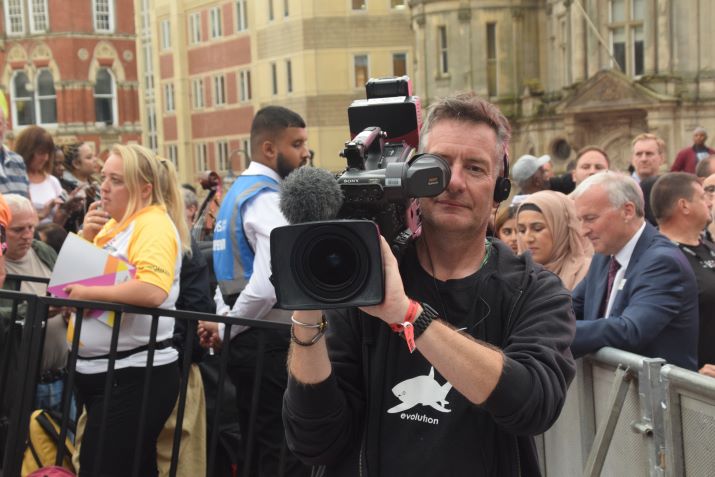
Ian Wagdin using one of the 5G cameras at the Commonwealth Games
Partnering for success
The trial so far has focused on the baton relay and the marathon at the Commonwealth Games. On Wednesday 27 July, The One Show became the first programme to use this type of technology at scale to cover the Queen’s Baton Relay as it arrived in Birmingham, with large crowds that would have the potential to swamp a normal network.
BBC R&D is working with BT Media & Broadcast, which has supplied the 5G network that runs on an Ericsson core, while Mobile Viewpoint has provided its Ultralink Air live stream professional H.264/H.265 encoder, plus technology that manages video streams over the networks.
Says Wagdin: “We had two live cameras each with a Mobile Viewpoint unit that took the video feeds and connected to the dedicated 5G network. The BT-provided network was in dedicated spectrum centred around 4050MHz. This enabled us to configure the network to favour uplink traffic, which is typical in a production environment, whereas public networks tend to support more downlink heavy applications.”
He continues: “[This is] a partnership with BT Media & Broadcast and Vislink’s Mobile Viewpoint. For all of us, it’s about finding the right working practices and the right form factors for the technology to make it a realistic proposition.
“The other key aspect of this trial is that we have no production facilities on site. The signals are passed through the 5G network and backhauled to a Mobile Viewpoint decoder based in our master control room in London. The two cameras are synchronised at this point so we can intercut if required. This option can be removed if latency is of more concern than sync. From there the output is decoded and sent to whichever gallery wants to use the cameras. This could be The One Show in London, BBC Sport in Salford or any of the Nations and Regions galleries around the UK. So basically we’ve got full remote production here as well. Any of the regions can just take it and put it on air. And it’s literally just as simple as switching it on, and that’s the other thing; it’s familiar kit to them.”
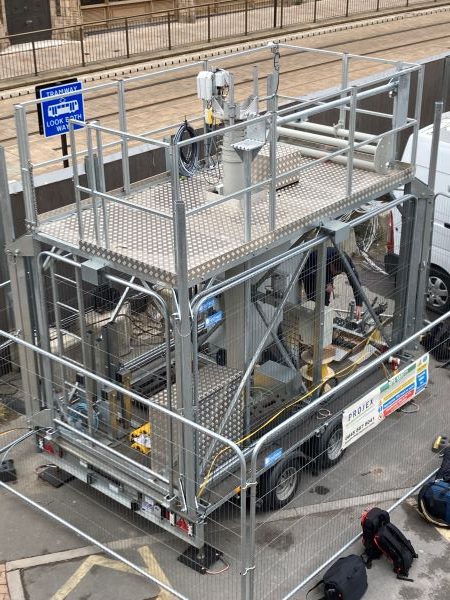
The BT Media & Broadcast 5G core on a trailer. Says Ian Wagdin: “The form factor is not ideal but the kit works well.”
Off the shelf interoperability
The other part of this trial which is a first is the fact that the technologies being used are off the shelf as opposed to customised or adapted. Explains Wagdin: “Up to now the technologies we have used on 5G trials have been not necessarily custom built, but adaptations of traditional radio cam technology; all of that is really important to us for low latency. But a big part of covering any event like this is actually getting out and doing the colour pieces and doing the bits that sit around that the main events themselves, so the opportunity to do that, that’s really our use case with this particular trial.
“In order to achieve that, the best way of architecting it for us was to work with Mobile Viewpoint because they have the capability in their WMT kit to support both 5G and 4G and other types of connectivity, so we thought it’s an ideal opportunity to see what happens when you move from a [5G] coverage area over to the public networks.
“We’re able to bond across both networks and then switch off the 5G and see what the behaviour is on the 4G,” Wagdin continues. “When we do that, when it’s crowded obviously we see the bit rates drop down and we see we need a lot more. The network can support up to about 150 megabits per second uplink capability on 5G. When the cameras move over to the public network that drops to between five and 10 megabits per second. We’re only running two cameras [on the 5G network here at the Commonwealth Games], but in theory, we could probably get up to about seven or eight cameras [on that bandwidth throughput], and if we drop the bandwidth, we could go more.”
Continues Wagdin, talking about the public network: “If you’ve got between five and 10 [megabits per second uplink] you can usually do HD, but the encoders have to work harder and you start to see artefacts and a whole bunch of other picture degradation issues.”
He adds: “It’s not possible to do a straight handover from the private to the public network and it would never be seamless [because of the degradation of signal]. But if you could get the kind of coverage that you wanted out of the public network, you wouldn’t deploy the private network; you expect the private network to be better. But the public network has advantages in terms of coverage and in terms of ubiquity, but we have no control over it so it’s all best efforts, at this stage; there’s no slicing or prioritisation on that network.
“Even if they’re 5G though, [these networks are] actually [based on] 4G cores [right now] so you’ve got a throttle point in the core that means that you are really only working in a not dissimilar way to how you would be working if you were on 4G. But the beauty of the private network is that we’ve got complete control, so that’s what’s enabled us to do the uplink versus downlink tuning, and it’s what enables us to point the antenna exactly where we want it.”

One of the 5G cameras being used to film The One Show live
Roaming cameras
The point of this part of the test is that with any private network, it is only possible to cover a finite and specific area, however with roaming cameras doing what 5G enables them to do, they will move around and they are likely to move outside of the network’s reach.
Says Wagdin: “5G gives our editorial colleagues the ability to go anywhere in the city centre, or anywhere, actually, in the UK, outside of the coverage area of our private network, still using the same kit, still using the same technology, still using the same crew. But it also provides us a little bit of a backup when you’re on the edge of coverage.
“But one of the things we’ve noticed with the 5G coverage that we’ve got is it’s far better than we were expecting; when you do these things you predict [range] but then you’re a little bit nervous about how far can you get. We’ve found that in walk tests the robustness of the 5G network and the way we’ve architected the 5G network – we’ve actually got two 5G SIMs that are bonded – means [the 5G network] outperforms our RF capabilities in terms of where things start to break up, where things get a little bit rubbish.”
However, he adds: “But there’s a whole bunch of metrics in there that means that it’s not quite an apple’s versus apple’s comparison, so it’s quite difficult for us to do a side by side coded orthogonal frequency division multiplexing (COFDM) to 5G comparison.”
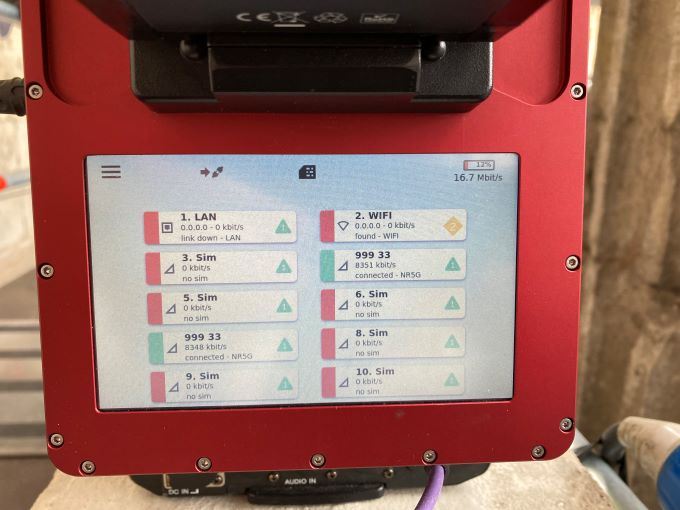
The Mobile Viewpoint camera back connected to the 5G network, streaming at 16.7MBps for HD
Role of regulators
Another area that BBC R&D wanted to look at in this trial is the role and support of regulators, in this case, Ofcom. Wagdin explains: “Working with Ofcom to get the licences that we need and not a fixed license was interesting. We’re only here for two weeks, so I don’t need a five year telecom spectrum licence to cover the site, I just need it for the two weeks. Also we’re working in a slightly different part of the priority spectrum than normal to the mobile network operators, because that then enables us to tune the uplink capabilities, so we can get more throughput on the uplink for our cameras; normally mobile networks are tuned to download.
“So we’ve retuned the network, and again, that’s not a normal thing to do, but it’s something that BT and Ericsson have the capability to do, but they’ve never really deployed it in a real world scenario before.”
He adds: “It’s an active conversation that we want to have with the regulators and in the 5G Records Project. We’re looking at those regulatory models and what we need to support them. And this is part of the story of that. In order to make the case, it really helps if you’ve got a demonstrable thing done, rather than just saying, “oh, in theory, we might want to do that”. I can now go and say, “well look, this is what we’ve done, and we’ve proven it works. This is what we need to support it in the future”.”
The trial is operating in a section of Ofcom’s spectrum that the regulator reserves for tests and experiments, partly because that gives a large enough barrier between this temporary network and the public network. Ofcom has a test and trial allocation which is 3800MHz to 4200MHz. It has allocated BBC R&D the 4050MHz channel within that band.
Says Wagdin: “We’re using the 4050MHz band. Public networks works slightly below that. [The section we’re using] is still within the 3GPP bands, but it’s not licenced out. We’ve got megahertz allocated to us, for this particular network, in a quite low power band so we’re not interfering with the public networks at all; we’re completely isolated from that, and that’s what gives us the capability to maintain high throughput, even when the crowds were here for the baton relay and the marathon. That gives us enough what they call, “guard bands”, so enough distance from the public networks, which tend to operate below that 3800MHz channel.”
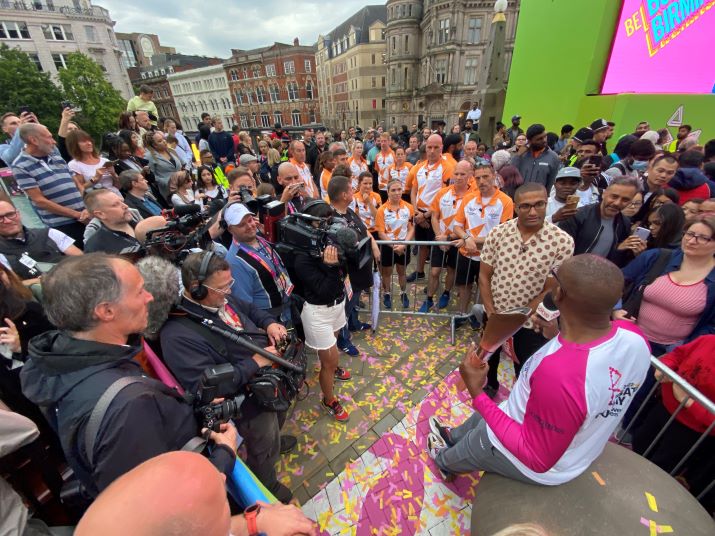
5G cameras working live at the Commonwealth Games with Sir Lenny Henry
Lots of learnings
Even though Wagdin is still in the middle of the trial at the Commonwealth Games, much is already being learned. He comments: “So number one the big message really is we can deploy these networks and they do the job that we want them to do. There’s still a long way to go in terms of how we make best use of the IP nature of the networks, the reverse channel; we’ve actually done quite a lot of work where Mobile Viewpoint can proxy into the encoders and tune the settings on the network, so in terms of a practical deployable workflow, then this is here.
“In terms of spectrum regulation and commercial, that’s the bit where both us and BT are kind of going, “okay, we know we can do it technically, but what are the challenges in terms of the commercial model? What are the challenges in terms of the spectrum model? What are the requirements needed to support this kind of operation?” Both sides have learned lots.”
He continues: “I think one of the big learnings actually, is how easy it is to do it. It’s not really hard. But the mobile industry wouldn’t like that message out there, because obviously they want people to think that it is harder, but the reality is that actually anybody can do this. It’s no harder than deploying any other type of network.”
All the partners are learning from the experiment, says Wagdin: “BT has obviously got lots of experience in building mobile networks and building telecoms networks, but they tend to be large scale and fixed, whereas [this network is] just coming in for a couple of weeks [during the Games]. Also a lot of OB’s, particularly sports OB’s, need to be extremely flexible and reactive, and so you need to be a little bit more agile in the approach [than BT is used to].
“So marrying those two approaches together has provided a lot of learning, I think on both sides. Obviously I can’t speak for BT Media & Broadcast, but I know that they’re learning a lot about what it means to deploy this kind of network in this kind of environment; it’s substantially different to their normal types of non-public networks, which tend to sort of go in for two to five years and are fixed.”
Another learning is that it is possible to deploy the network with a far lighter footprint than anticipated. Wagdin says: “I would probably push harder not to have a big trailer [for the 5G kit]. I don’t need it. I could just put it in a rack underneath the stage. On the deployment model, we’ve got [kit] bolted on the antennas bolted onto the scaffolding, which needs specialist riggers and people, but I can probably just put those up on magic arms or something like that, and then it’s a little bit more flexible.”
Wagdin concludes: “Probably the next conversation is with DCMS and Ofcom and actually having a demonstrable thing that we’ve done means that it’s not, “it’ll give us that in theory,” it’s actually, “this is the type of thing we can do, and this is why we need these types of environments”.”
He goes on: “As with all R&D trials, the key purpose is learning and informing what may happen with future workflows. The teams have worked together to understand the challenges of providing a robust solution that matches or exceeds existing capabilities. The trial will continue for the duration of the games.
“Of course technology never stands still and this is the first step on a journey that will see both mobile technologies and broadcast technologies evolve,” Wagdin concludes. “We have plans to harmonise our workflows to better support production operations and reduce cost and complexity whilst increasing flexibility and reliability. By making full use of the IP nature of 5G networks we will start to see more of the benefits that come from remote and connected production.”
More learnings from both BBC R&D and BT Media & Broadcast on this trial will be released over coming weeks, and full reports will be available at IBC in Amsterdam.
The 2022 Commonwealth Games took place 28 July to 8 August in Birmingham.

